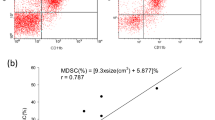Abstract
Using an under agarose migration (UAM) assay, we studied lymphokine-activated killer (LAK)-attractant activity in cultured conditioned medium of tumour tissues after chemotherapy as a possible mechanism of enhanced LAK cell accumulation into tumour tissues after chemotherapy. BMT-11 is a fibrosarcoma developed in C57BL/6 mice. The conditioned medium of BMT-11 tumour tissues obtained from mice treated with various anti-cancer drugs had chemotactic activity for LAK cells (LAK-attractant activity). mRNA expression of interleukin (IL)-1 alpha, IL-6, IL-8, interferon (IFN)-gamma, and tumour necrosis factor (TNF)-alpha was observed in untreated tumour tissues, which were not enhanced by cyclophosphamide treatment. mRNA expression of TGF-beta 1 was not detected in untreated tumour tissues by reverse transcription-polymerase chain reaction (RT-PCR), but was detected in tumour tissues treated with cyclophosphamide. Recombinant human TGF-beta 1 showed LAK-attractant activity at a concentration of 0.1 ng ml-1 and 1 ng ml-1, whereas fresh splenocytes were not attracted by TGF-beta 1. Anti-TGF-beta 1 antibody inhibited LAK-attractant activity in the conditioned medium of tumour tissues treated with cyclophosphamide to approximately 35% that of control at 100 micrograms ml-1. These findings indicate that TGF-beta 1 produced in the tumour tissues of mice treated with anti-cancer drugs could be a LAK attractant. By a 4 h 51Cr release assay of natural killer cell-resistant BMT-11 tumour cells, we observed that TGF-beta 1 at a concentration from 0.01 ng ml-1 to 10 ng ml-1 did not inhibit LAK activity in an effector phase. Taken together, we suggest that TGF-beta 1 produced in tumour tissues after chemotherapy participates in gathering transferred LAK cells and contributes to the therapeutic effects of transferred LAK cells.
This is a preview of subscription content, access via your institution
Access options
Subscribe to this journal
Receive 24 print issues and online access
$259.00 per year
only $10.79 per issue
Buy this article
- Purchase on Springer Link
- Instant access to full article PDF
Prices may be subject to local taxes which are calculated during checkout
Similar content being viewed by others
Author information
Authors and Affiliations
Rights and permissions
About this article
Cite this article
Kuramitsu, Y., Nishibe, M., Kobayashi, M. et al. Transforming growth factor beta 1 (TGF-beta 1) produced in tumour tissue after chemotherapy acts as a lymphokine-activated killer attractant. Br J Cancer 74, 274–279 (1996). https://doi.org/10.1038/bjc.1996.351
Issue Date:
DOI: https://doi.org/10.1038/bjc.1996.351
This article is cited by
-
Contradictory concepts in the etiology and regression of kaposi’s sarcoma
Pathology & Oncology Research (1996)



